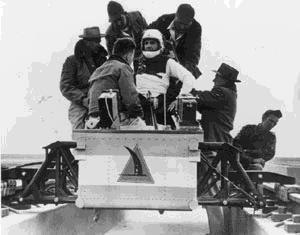Murphy's Laws
Deutsche Version
Homepage About me Satellitephotos Family Tree Sorbs Murphy's Laws Mandelbrot Mensa Riddles Links
Disclaimer
On this site you can find the truth about Murphy.
back to Murphy's Law.
Here it goes to all Corollaries I collected.
Here you can search in them for words.
 The following article was excerpted from "The Desert Wings".
The following article was excerpted from "The Desert Wings".
March 3, 1978
by the AFFTC History Office
Murphy's Law ("If anything can go wrong, it will!") was born here (Edwards Air Force Base) - in 1949 at North Base.
It was named after Capt. Edward A. Murphy, an engineer working on Air Force Project MX981, a project designed to see how much sudden deceleration a person can stand in a crash.
One day, after finding that a transducer was wired wrong, he cursed the technician responsible and said, "If there is any way to do it wrong, he'll find it."
The contractor's project manager kept a list of "laws" and added this one, which he called Murphy's Law.
Actually, what he did was take an old law that had been around for years in a more basic form (see first paragraph above) and give it a name.
Shortly afterwards, the Air Force doctor (Dr. John Paul Stapp) who rode a sled on the deceleration track to a stop, pulling 40 Gs, gave a press conference. He said that their good safety record on the project was due to a firm belief in Murphy's Law and in the necessity to try and circumvent it.
Aerospace manufacturers picked it up and used it widely in their ads during the next few months, and soon it was being quoted in many news and magazine articles. Murphy's Law was born.
The Northrop project manager, George E. Nichols, had a few laws of his own. Nichols' Fourth Law says, "Avoid any action with an unacceptable outcome."
The doctor, well-known Col. John P. Stapp, had a paradox: Stapp's Ironical Paradox, which says, "The universal aptitude for ineptitude makes any human accomplishment an incredible miracle."
-to the top-
From a letter of the namer of the law:
The event occurred in 1949 at Edwards Air Force Base, Muroc, California, during Air Force Project MX981. This was Col. J.P. Stapp's experimental crash research testing. The work was being accomplished by Northrop Aircraft, under contract from the Aero Medical Lab at Wright Field.
I was the Northrop's project manager.
Capt. Ed Murphy was a development engineer for Wright Field Aircraft Lab. Frustrated with a strap transducer which was malfunctioning due to an error in wiring the strain gage bridges caused him to remark - "If there is any way to do it wrong, he will" - referring to the technician who had wired the bridges at the lab.
I assigned "Murphy's law" to the statement and the associated variations.
A couple of weeks after the "naming" Col. Stapp indicated, at a press conference, that our fine safety record during several years of simulated crash force testing was the result of a firm belief in Murphy's Law, and our consistent effort to deny the inevitable.
Several companies started using this in their commercials.
Murphy's Law was now established and spreading fast.
Sincerely
George E. Nicholas
Reliability & Quality Assurance Mg
Viking Project
Jet propulsion Lab - NASA
-to the top-
In case of questions or suggestions just write an Email to me.